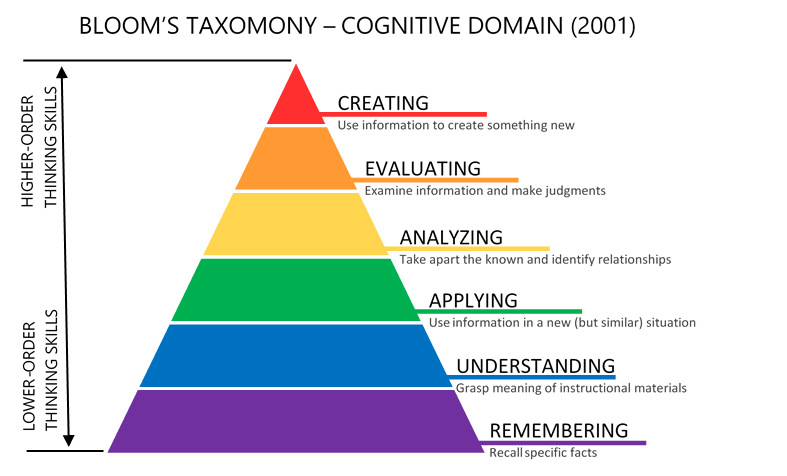Bloom’s Taxonomy
Together with Edward Gurst, David Krathwohl, Max Englehart and Walter Hill, psychologist Benjamin Bloom released Taxonomy of Educational Objectives in 1956. This framework would prove to be valuable to teachers and instructors everywhere as it allowed educators to categorize learning goals. It would later become popularly known as Bloom’s Taxonomy.
See also: Using Bloom’s Taxonomy to Write Effective Learning Objectives: The ABCD Approach
Bloom’s original framework had six main categories: Knowledge, Comprehension, Application, Analysis, Synthesis, and Evaluation. Knowledge was considered the base category for all other learning, meaning that the rest of the “skills and abilities” that followed were dependent on the acquisition of knowledge.

Even though the last five were considered to be skills and abilities, Bloom’s Taxonomy is most remembered by these six categories. These categories can be imagined on a continuum to demonstrate that learning is ongoing. Each learner moves from simple and concrete to complex and abstract ideas.
Although its original name was the Taxonomy of Educational Objectives, this was not always the best description. Bloom created his categories based on the complexity of skills and understanding. An image of a pyramid (see below) is often used to show how the level of difficulty increases as the learner moves up to the next category. Instructors are able to use this hierarchy to develop tasks based on the learning goals for a particular course.
Bloom’s Taxonomy follows a hierarchy, which, like many other theories, supports the idea that learning is built on prior knowledge and skills already learnt. The pyramid demonstrates how each learning outcome must be achieved before moving onto the next level.
See also: How to Create Effective Multiple Choice Questions
Bloom’s Original Taxonomy, 1956
- Knowledge: The student is able to recall specific information, ideas, and facts, or is aware of particular patterns in rehearsed settings.
- Comprehension: The student demonstrates understanding of the processes taught without having to make connections to explicitly stated ideas.
- Application: The student is able to apply the knowledge taught to an idea rather than a particular event.
- Analysis: The student is able to decipher ideas or explicitly express information in parts.
- Synthesis: The student is able to assemble information together to form cohesive ideas.
- Evaluation: The student is able to develop judgements about the material provided in order to meet the learning objective.
See also: Formative and Summative Assessment
Bloom’s Revised Taxonomy, 2001
Bloom’s Taxonomy underwent a review at the beginning of the 21st century, and emerged with a new title: A Taxonomy for Teaching, Learning, and Assessment. The new title is significant because it moves away slightly from Bloom’s original idea of “educational objectives”. The psychologists, researchers and theorists involved in the revision of Bloom’s Taxonomy aimed for a more dynamic idea of classification, which included testing, instruction, and assessment.
- Remembering: involves retrieving prior knowledge from long-term memory and using the connections to aid in current understanding.
- Understanding: includes using strategies to draw conclusions from current information, such as summarizing and interpreting ideas, comparing meaning from messages, and interpreting both oral and written texts.
- Applying: requires implementing the procedure for learning.
- Analyzing: entails dividing information into meaningful parts, while ensuring that they the parts remain relevant to the each other and the overall goal.
- Evaluating: includes critiquing and assessing information based on the outline learning criteria.
- Creating: involves organizing the ideas into a new structure to form a coherent pattern of understanding.
The benefits of using Bloom’s Taxonomy
Much taxonomy is used in developing courses and organizing material for students. Bloom’s Taxonomy is arguable the most famous and most widely-used of these structures.
In their revision of the Bloom’s original structure, the researchers suggested a multi-layered answer to the question “Why use Bloom’s Taxonomy?” There are some important points for instructors to remember in the creation of course outlines.
- It is important to outline learning objectives in order for both students and instructors to understand the purpose of each exchange in class.
- Learning goals can be easily clarified and understood by both the students and the instructor if the objectives are organized.
- There are many benefits to organized learning goals for the instructor:
- they are able to create appropriate activities
- they are able to develop relevant instructional strategies
- they are able to review whether both the instruction and the evaluations are consistent with the learning objectives.
See also: How Can We Align Learning Objectives, Instructional Strategies, and Assessments?
Using Bloom’s structure with learning goals
Bloom’s structure enables a solid base from which you can easily create learning goals. It also provides an outline from which you can develop expectations for each level of understanding. Rubrics with clear objectives at each level help students identify what they have achieved at each point in the course.
In addition to helping develop expectations, Bloom’s Taxonomy assists in developing instructional strategies. Instructors are able to refer to the learning objectives throughout the development process, which enables them to create activities that build on student understanding. Slowly increasing the difficulty of tasks promotes memory and thorough understanding. Students are then able to achieve the learning goals if there are clear strategies on how to do so.
There are supports to assist instructors in developing learning goals using Bloom’s Taxonomy. Bloom has a “verb table” that outlines the levels of knowledge and the action verbs associated with that level of understanding. The table below also provides an example of a learning objective for that particular level.
Bloom’s six levels begin with the most basic understanding and then increase in complexity. Each level also reflects the type of activities that the student will perform or practice at that level of understanding. The verbs associated with each of Bloom’s levels are also associated with the essential question central to that level itself.
Bloom’s Taxonomy Action Verbs
| Bloom’s Level | Key Verbs | Examples of Learning Goal (with the cognitive processes in italics) |
| Create (Create, build or develop something new.) | design, formulate, build, invent, create, compose, generate, derive, modify, develop, adapt, change, combine, compile, compose, construct, delete, develop, discuss, elaborate, formulate, improve, invent, solve, minimize, maximize, imagine, delete, revise, propose, facilitate, hypothesize, integrate, negotiate, role-play | By the end of this lesson, the student will be able to create a question and answer-style problem about the conservation of energy. |
| Evaluate (Use information to make judgments.) | choose, support, relate, determine, defend, judge, grade, compare, contrast, argue, justify, support, convince, select, evaluate, appraise, award, assess, conclude, criticize, decide, deduct, determine, estimate, importance, interpret, measure, prove, rate, recommend, select, editorialize, rank, rate, summarize | By the end of this lesson, the student will be able to justify their choice for the conservation of energy or the conservation of momentum. |
| Analyze (Identify schemas or relationships.) | classify, break down, categorize, analyze, diagram, illustrate, criticize, simplify, associate, assume, examine, distinguish, inspect, simplify, test for, discover, dissect, divide, function, interference, deduce, discriminate, plan, separate | By the end of this lesson, the student will be able to analyze the differences between kinetic and potential energy |
| Apply (Use information in a new situation.) | calculate, predict, apply, solve, illustrate, use, demonstrate, determine, model, perform, present, build, choose, develop, construct, experiment with, identify, interview, organize, plan, select, utilize, make use of, employ, chart, compute, change, explain, illustrate, manipulate, modify, operate | By the end of this lesson, the student will be able to predict the kinetic energy of a projectile. |
| Understand (Grasp meaning of materials.) | describe, explain, paraphrase, restate, give original examples of, summarize, contrast, interpret, discuss, classify, compare, contrast, demonstrate, extend, illustrate, infer, outline, relate, show, translate, predict, associate, trace, transform, record, reproduce, retell | By the end of this lesson, the student will be able to paraphrase Newton’s law of motion. |
| Remember (Recall specific facts.) | list, recite, outline, define, name, match, quote, recall, identify, label, recognize, tell, spell | By the end of this lesson, the student will be able to name Newton’s three laws of motion. |
See also: Vygotsky’s Zone of Proximal Development and Scaffolding

